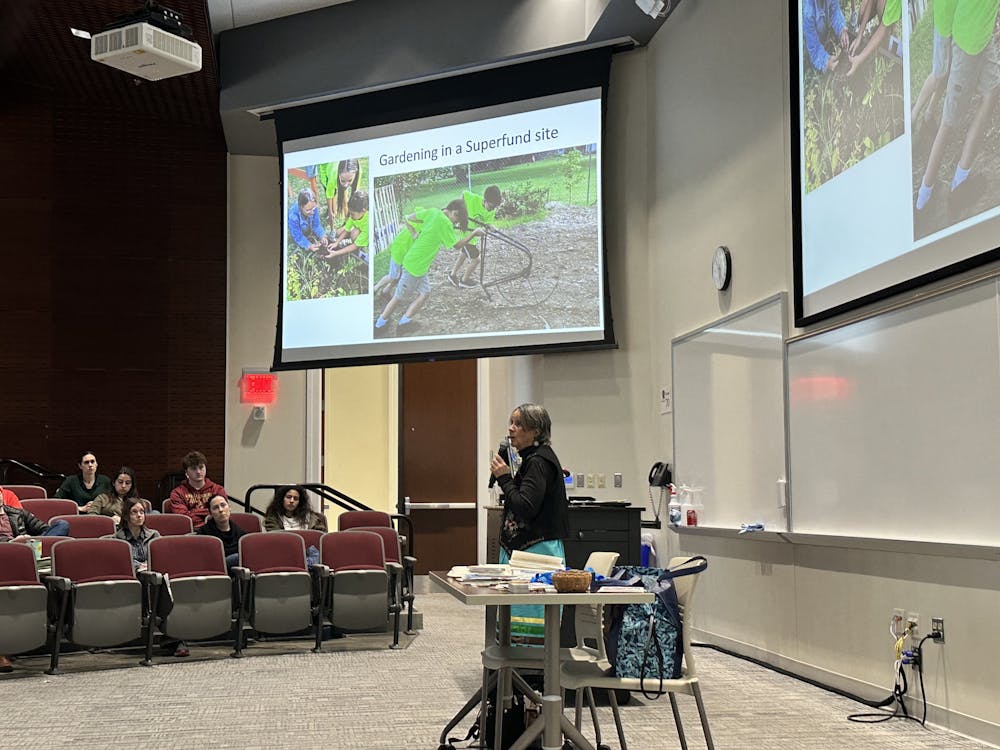Miami University faculty and students listened as environmental activist Rebecca Jim advocated change and healing for the tribal lands in northeastern Oklahoma on Thursday, Feb. 15.
Jim is a member of the Cherokee Nation and founder of the environmental justice organization Local Environmental Action Demanded (LEAD). Her activism is centered around Tar Creek, which runs from southeast Kansas to the Neosho River just south of Miami, Oklahoma, and empties into the Pensacola Dam.
Tar Creek is the oldest Superfund site — locations polluted with hazardous materials — in the United States. It runs through nine tribal nations, distributing toxic air, soil and water across 40 square miles. Since 1979, Tar Creek has been tainted orange due to the extreme amounts of heavy metals and toxic mine waste.
“We are all friends of Tar Creek,” Jim said. “I’m recruiting you, and clean water is our right.”
Northeastern Oklahoma was once a lead and zinc mining hub from the first half of the 20th century to the 1960s when the mines closed. However, after closing, they left behind vast amounts of chat — fragments of siliceous rock, limestone and dolomite waste. This waste bleeds into Tar Creek through overflowing aquifers — underground reservoirs — that the mines were built on top of.
Tar Creek was once central to the lives of many indigenous communities, serving as a place where people would fish, and children would play. But in 1979, “at least a million gallons of mine water a day were flowing downstream — sometimes much more,” according to Sierra Club, an American nonprofit environmental organization.
“Last December, we did receive the word from the [Environmental Protection Agency] that … they had done some sampling and [they said,] ‘No, children should not play here,’” Jim said. The results come after years of ignoring the severity of the situation and lack of publicity of the issue.
According to data collected by the Indian Health Service in the early 1990s, a third of children at the Miami clinic had elevated lead levels in their blood. Eight miles north in the town of Pitcher, 34% of the children were found to be suffering from lead poisoning.
When flooding occurs, the waters rise, taking with them the toxic metals. Jim, through her work in the creek, came across a student-built dam one day and led a group to remove it. She then discovered other dams built by federal agencies and the state, which increased the risk of flooding for upstream communities.
The Federal Energy Regulatory Commission (FERC) made a recent statement in January, linking the Grand River Dam Authority (GRDA) — which runs the Pensacola Dam — with increased flooding upstream in Miami, Oklahoma, where the Miami Tribe is located.
“They are still putting [the dams] up and we’re still going to take them down,” Jim said. “They shouldn’t ever build the dams.”
To educate the community about the toxicity of the water, Jim began taking people on “toxic tours” to show them the extent of the damage and fishing tournaments to show how virtually all wildlife has been killed. The students also got involved by calculating the percentage of heavy metals in the water and making posters informing the public of the problem.
Enjoy what you're reading?
Signup for our newsletter
“After all these years, they’ve waited generation after generation to reclaim the place their grandparents swam,” Jim said.
After the city failed to remove asbestos and benzene from a decommissioned factory outside Miami, Jim and groups of students began to educate the community about the problem, making PowerPoints and writing letters to the city demanding action. Their activism resulted in a $2 million emergency fund to clean up the site.
While the EPA and other agencies have taken action by replacing soil in yards and parks, large amounts of toxic sediment remain in the water and soil. Much of the local action has stemmed from Jim and her students’ efforts to clean the community.
“I noticed that she was very disappointed because of the lack of [government] action that had been taken in so many years,” said Ian McCarty, an environmental science major. “I was expecting more of a resolution, but they’re still in the process of fixing the problem.”




